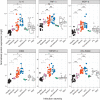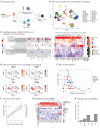Systems biological assessment of immunity to mild versus severe COVID-19 infection in humans
- PMID: 32788292
- PMCID: PMC7665312
- DOI: 10.1126/science.abc6261
Systems biological assessment of immunity to mild versus severe COVID-19 infection in humans
Abstract
Coronavirus disease 2019 (COVID-19) represents a global crisis, yet major knowledge gaps remain about human immunity to severe acute respiratory syndrome coronavirus 2 (SARS-CoV-2). We analyzed immune responses in 76 COVID-19 patients and 69 healthy individuals from Hong Kong and Atlanta, Georgia, United States. In the peripheral blood mononuclear cells (PBMCs) of COVID-19 patients, we observed reduced expression of human leukocyte antigen class DR (HLA-DR) and proinflammatory cytokines by myeloid cells as well as impaired mammalian target of rapamycin (mTOR) signaling and interferon-α (IFN-α) production by plasmacytoid dendritic cells. By contrast, we detected enhanced plasma levels of inflammatory mediators-including EN-RAGE, TNFSF14, and oncostatin M-which correlated with disease severity and increased bacterial products in plasma. Single-cell transcriptomics revealed a lack of type I IFNs, reduced HLA-DR in the myeloid cells of patients with severe COVID-19, and transient expression of IFN-stimulated genes. This was consistent with bulk PBMC transcriptomics and transient, low IFN-α levels in plasma during infection. These results reveal mechanisms and potential therapeutic targets for COVID-19.
Copyright © 2020 The Authors, some rights reserved; exclusive licensee American Association for the Advancement of Science. No claim to original U.S. Government Works.
Figures






References
-
- Grifoni A., Weiskopf D., Ramirez S. I., Mateus J., Dan J. M., Moderbacher C. R., Rawlings S. A., Sutherland A., Premkumar L., Jadi R. S., Marrama D., de Silva A. M., Frazier A., Carlin A. F., Greenbaum J. A., Peters B., Krammer F., Smith D. M., Crotty S., Sette A., Targets of T Cell Responses to SARS-CoV-2 Coronavirus in Humans with COVID-19 Disease and Unexposed Individuals. Cell 181, 1489–1501.e15 (2020). 10.1016/j.cell.2020.05.015 - DOI - PMC - PubMed
-
- Hadjadj J., Yatim N., Barnabei L., Corneau A., Boussier J., Smith N., Péré H., Charbit B., Bondet V., Chenevier-Gobeaux C., Breillat P., Carlier N., Gauzit R., Morbieu C., Pène F., Marin N., Roche N., Szwebel T.-A., Merkling S. H., Treluyer J.-M., Veyer D., Mouthon L., Blanc C., Tharaux P.-L., Rozenberg F., Fischer A., Duffy D., Rieux-Laucat F., Kernéis S., Terrier B., Impaired type I interferon activity and inflammatory responses in severe COVID-19 patients. Science 369, 718–724 (2020). 10.1126/science.abc6027 - DOI - PMC - PubMed
Publication types
MeSH terms
Substances
Grants and funding
LinkOut - more resources
Full Text Sources
Other Literature Sources
Molecular Biology Databases
Research Materials
Miscellaneous

